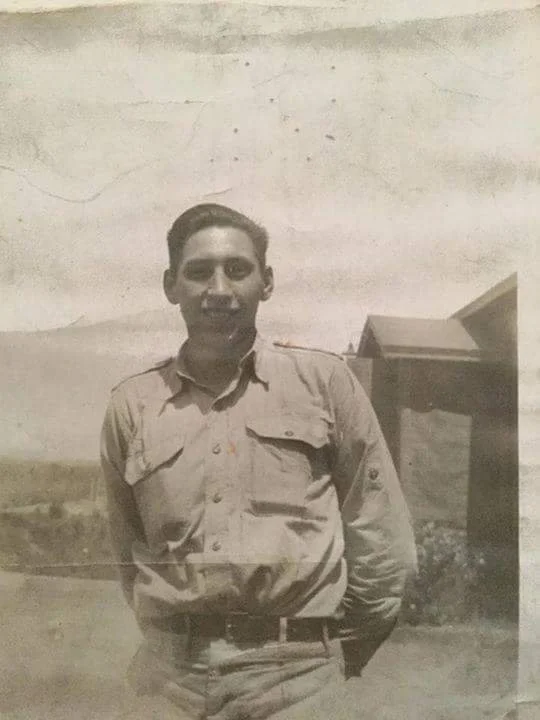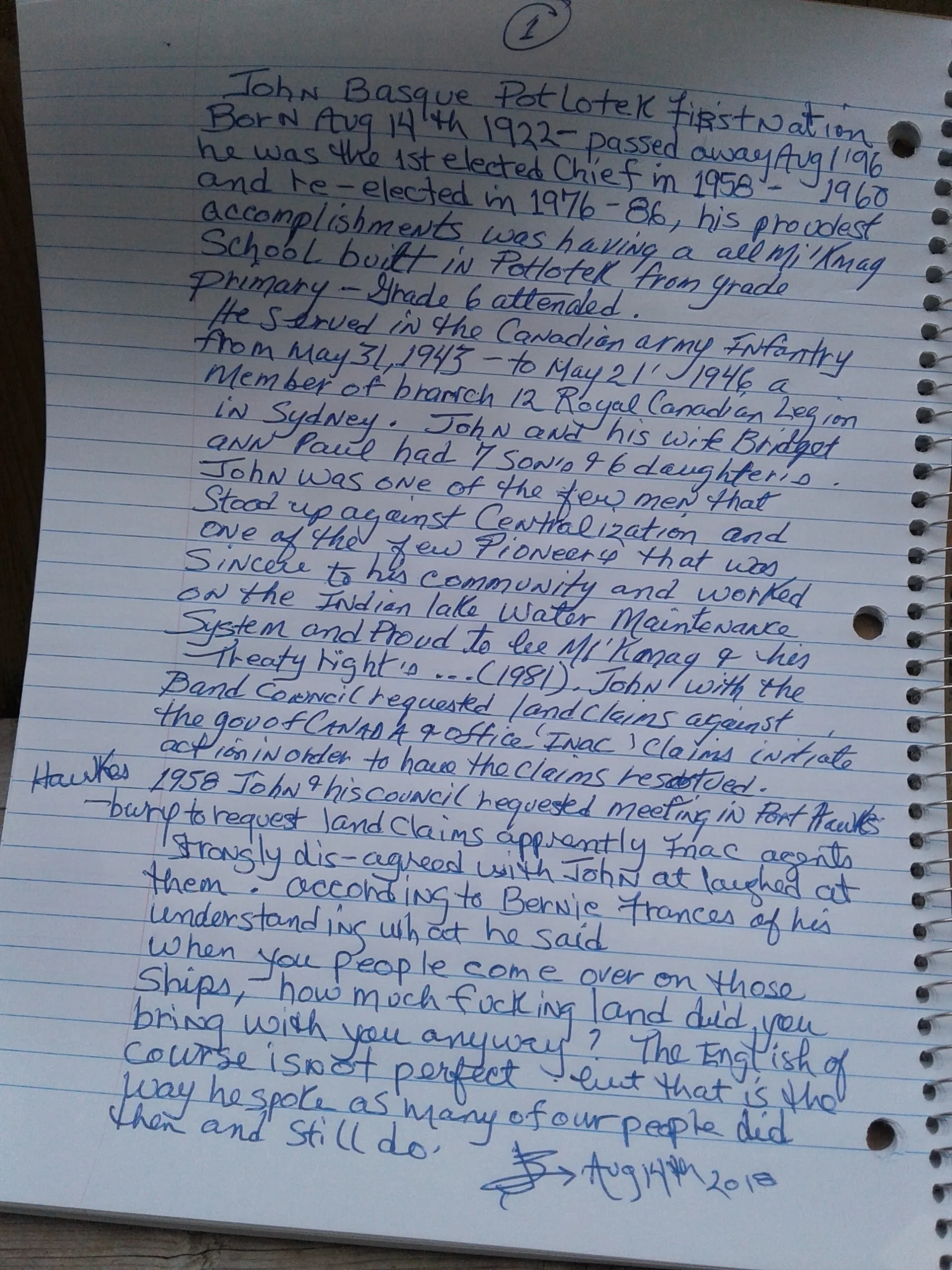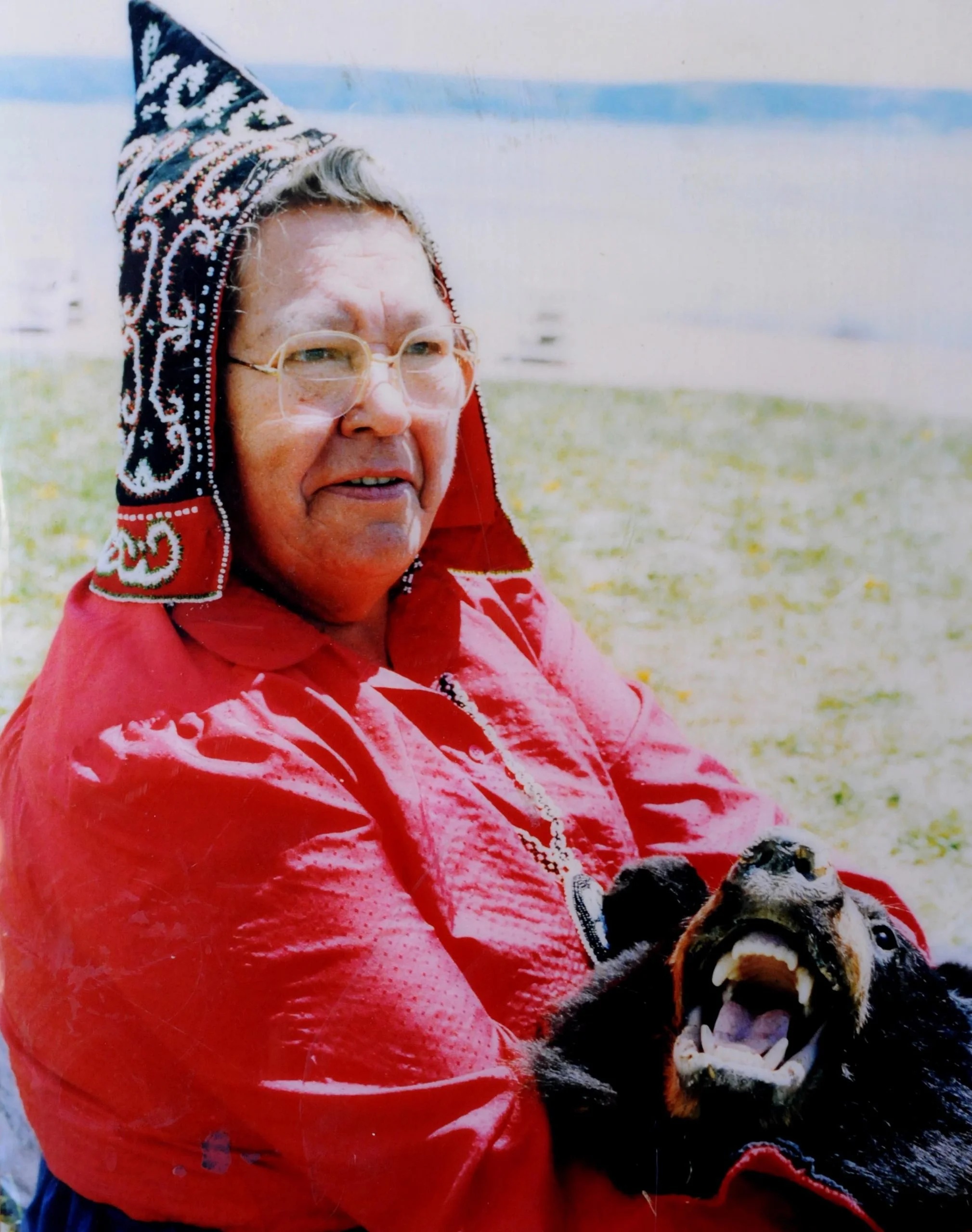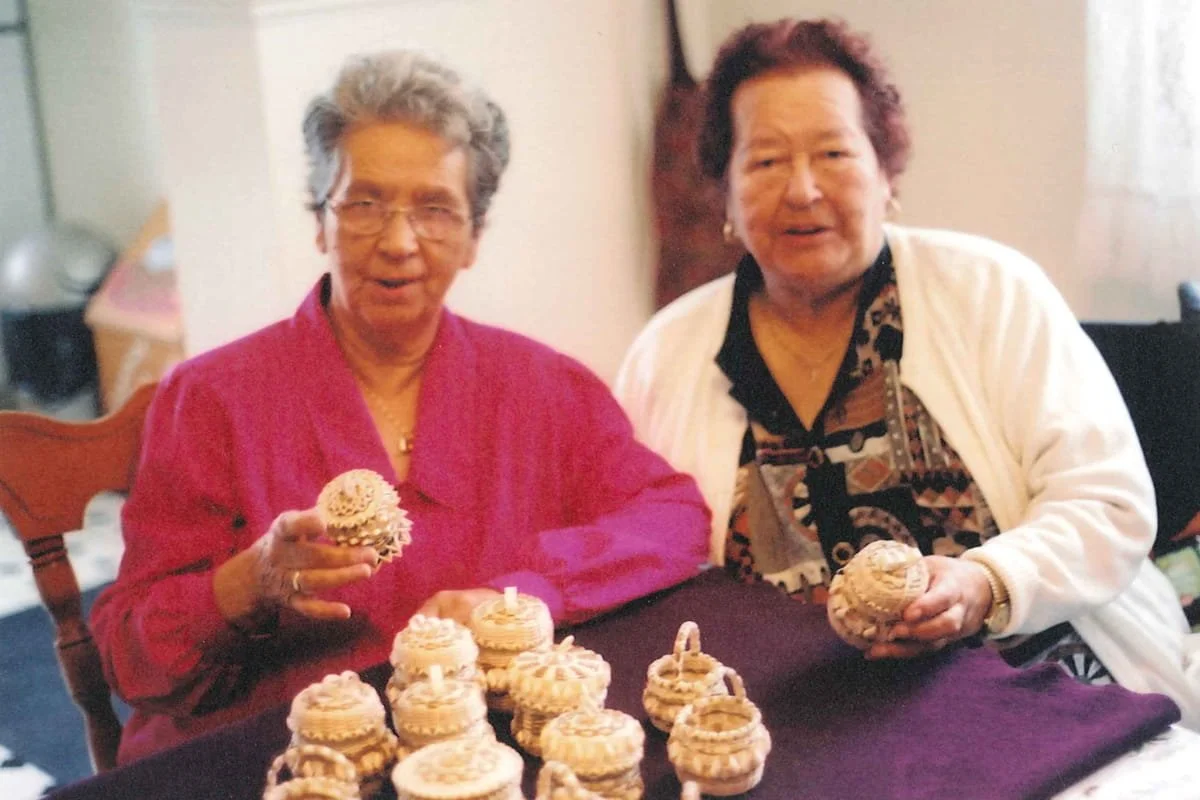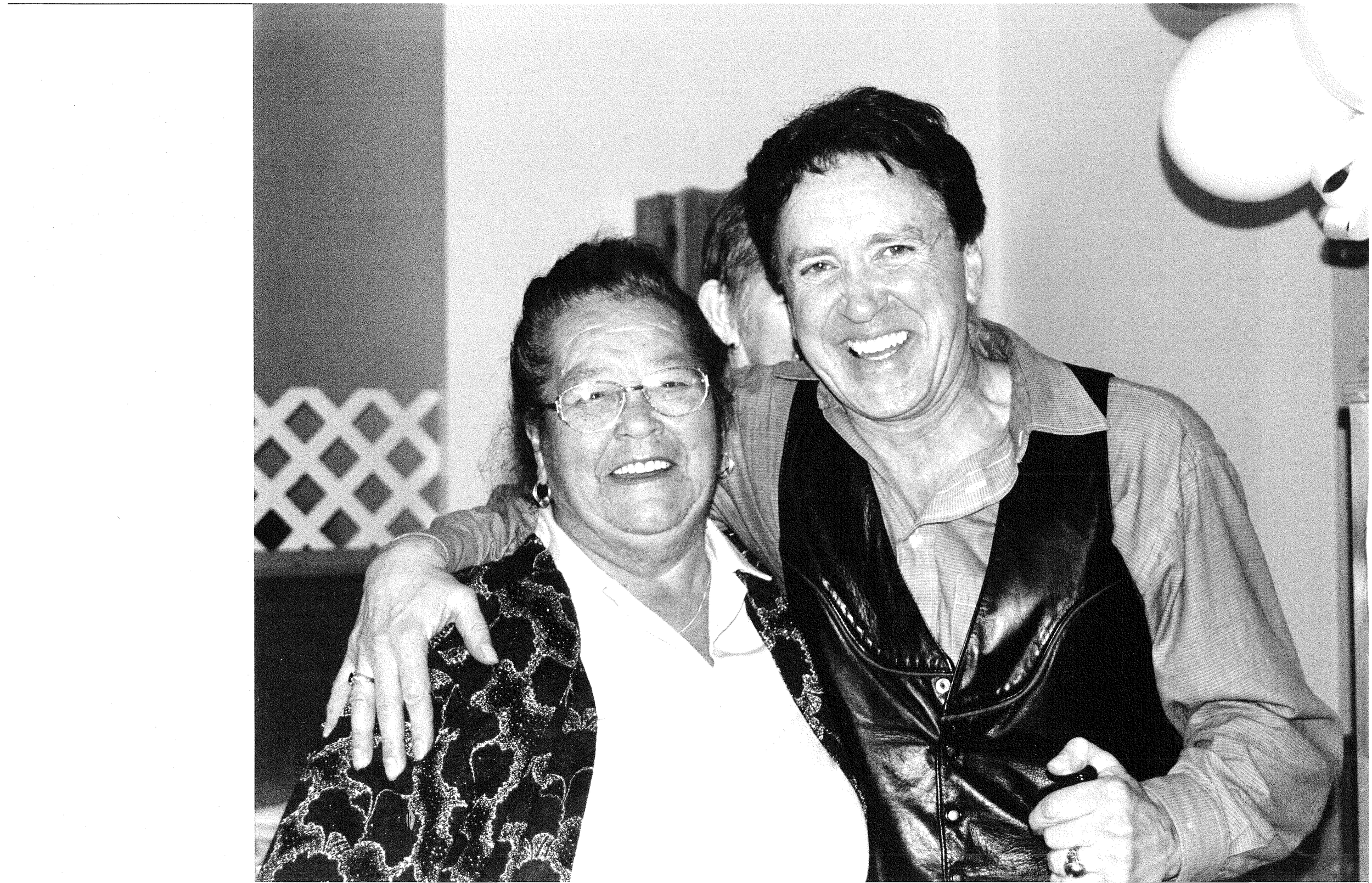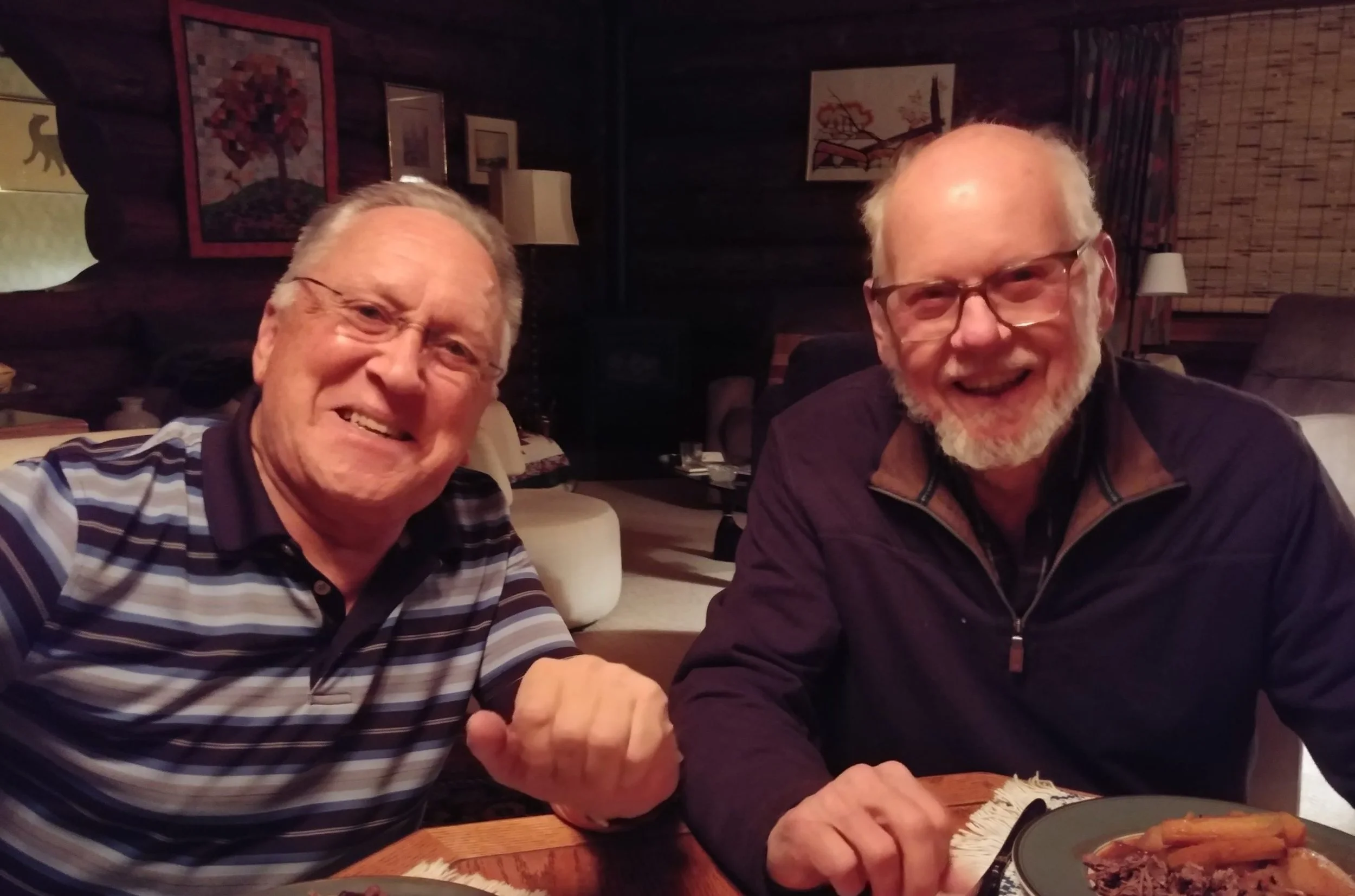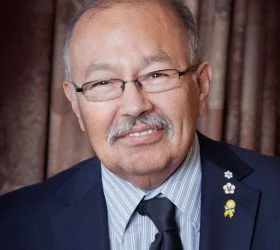Biographies & Photos
The Mi'kmaq of Nova Scotia Archives Collection - Curated by Dr. Trudy Sable
Overview on Terms of Use
All of the interviews offered in this collection are approved to be shared by the individual interviewee or surviving family members. Each recording and transcript include information regarding how to cite the material, as well as information about the person, place, project, date, and resulting publication or resource if any. Some supplemental material, such as biographies, Mi’kmaw translations of terms and text, and pictures, are included with hopes of adding more in the coming years. Special thanks to Kenny Prosper and Bernie Francis for their support and their translations of terms and text into the Smith/Francis orthography.
Since a great deal of time and effort has gone into this project with more to come, we would like to make the following request regarding its Terms of Use:
1. Our primary objective is to make this material available to Mi’kmaw community members and organizations for use in whatever ways would further the knowledge of their history and culture and promote the wellbeing of future generations.
2. For researchers and educators not of Mi’kmaw descent, and who are interested in the use of any of this material for non-commercial or not-for-profit purposes, we would like to request you contact us with the intended uses and outcomes for your research or project by filling out the attached short form. This helps us (the MNFC and its Board of Directors) to understand the benefits of your research.
3. If the material is being used for commercial publications, films, on-line materials, or other data gathering or generating uses, we ask to be contacted directly for permission. We may request a fee be paid for its use. The fee will be invested in a youth capacity fund to support Mi’kmaw youth training in research and archival skills development.
Whatever the use of the material, donations to the MNFC are welcome to support our ongoing work.
*See below for contact information
Late Chief John Basque of Potlotek First Nation
Written by Jerome Basque, son of late John Basque. Aug. 14th, 2018
Sa’n Pask, Potlotekewey Wutan. Weskijinuip, Kisikewiku’s, 14 te’sukunikek, 1922ek aq nepk Kisikewiku’s, 1 te’sukunikek, 1996ek. Amkwesewey meknup Saqmawin 1958ek mi’soqo 1960ek aqq ap meknup 1976ek mi’soqo 1986ek. Ta’n koquey mawi mkite’tkip ta’n kisa’toqip na Mi’kmawey kina’matinewo’kuom Potlotek weja’tekemk poqji kina’masij wen primary miso’qo grade 6 eliaqip.
Naspip Sa’n app Sma’kniswey weja’tekemk Ejquljuiku’s 31 te’sukunikek mi’soqo Ejquljuiku’s 21 te’sukunikek, 1946ek. Aqq naspip Branch 12 Royal Canadian Legion, Sitni. Sa’n aqq wte’pitema Plsit A’no’q luiknek te’silipni wkwisua aq asukom te’silipni wtusua. Sa’n na newte’jip ji’nm ta’n matnkip centralization aqq amskwesewa’juip nikana’toqip kjitmiw wutanm aqq melki maliaptikip L’nui quspemk samqwan ta’n wejiaqip aqq mekite’tkipn keta’matultimkewe’l wejkuiaqmulti’kul…(1981). Sa’n aqq band kawnsilerenk kwilutmi’tip maqamikal apankitasikn wjit kinu Kaplnu’lewiktuk, (INAC) aqq panta’toqip ta’n tli matnitaqq aqq klapis ilsutasin.
1958ek Sa’n aqq wkawnsileremk kwilutmi’tip mawiwlteskatultimk Aksiperi kwilutmnew maqamikewey apankituewey, katu Kaplnu’l wlukewinu’mk melki mu welte’tmi’tikip aqq Sa’nal wi’kuama’tipn. Plna’l Plansis tel nutmas ta’n telimasni Sa’no’q. Ta’n tujiw kilew pejitaioqek welipotmuaq ta’sik fakkin maqamikew pekisituoqsip apukey? Ta’n teli Aklasie’wisip na’sik mu mujkajewey katu teli’sip na aqq pikwelkik kikmanaq teli’sultipnik aqq me ne’kaw teli’sultijik.
J.B. (Jerome Basque Aug 14th 2018)
John Basque, Potlotek First Nation. Born Aug 14th 1922 – passed away Aug 1st 1996. He was the 1st elected chief in 1958 – 1960 and re-elected in 1976 – 1986, his proudest accomplishments was having an all Mi’kmaq school built in Potlotek from grade primary to grade 6 attended.
He served in the Canadian Army Infantry from May 31st 1943 – to May 21st 1946, a member of branch 12 Royal Canadian Legion in Sydney. John and his wife Bridget Ann Paul had 7 sons and 6 daughters. John was one of the few men that stood up against centralization and one of the few pioneers that was sincere to his community and worked on the Indian Lake Water Maintenance System and proud to be Mi’kmaq and his Treaty rights…(1981). John with the band council requested land claims against the government of Canada and office ‘INAC’ claims initiate acquisition in order to have the claims restored.
1958 John and his council requested meting in Port Hawkesbury to request land claims apparently INAC agents strongly disagreed with John and laughed at them. According to Bernie Francis of his understand what he said. “When you people come over on those ships, how much f***ing land did you bring with you anyway?” The English of course is not perfect, but that is the way he spoke as many of our people did then and still do.
Late Dr. Margaret “Granny” Johnson of Eskasoni First Nation
Written by George Paul, Grandson, Eskissoqnik (Eskasoni) First Nation in Cape Breton, Nova Scotia.
If there was one person who truly exemplified the character of the Mi’kmaw Nation, Margaret Johnson, who was better known as Dr. Granny, was truly a reflection of the hardships, the struggles, the triumphs, the growth, and the genuine humor of the Mi’kmaw people.
Dr. Margaret Johnson was born on August 10, 1915 and lived an incredible 95 years. She passed away on Saturday, Oct. 16, 2010. Her parents were Michael and Janie Paul from Potlotek (Chapel Island) First Nation in Cape Breton, Nova Scotia. They had twelve children in all. Her father was a fisherman and lumberjack, and her mother made baskets for extra income along with making the clothes for the family. Dr. Granny and her sisters picked up these skills at a very young age.
Her first marriage was with Albert Julian from Paqtnkek (Afton) First Nation in Nova Scotia. She lived in Paqtnkek for seven years until Albert’s untimely death in 1940. She moved back home with her children then later met up with John T. Johnson from Potlotek (Chapel Island). They married in 1947 and were promised a new home in Eskissoqnik (Eskasoni) First Nation with electricity and indoor plumbing.
When they arrived in Eskissoqnik, only the frame-work of their new house was completed and had no electricity or plumbing. They both worked hard and raised ten children of their own plus three from the previous marriage, along with raising two grandchildren. In total, Dr. Granny raised 15 children and was a grandmother to 85 grandchildren, 153 great-grandchildren and 19 great-great grandchildren.
Dr. Granny was an expert in basket making, bead working and sewing, and taught these crafts in Eskissoqnik, Lennox Island, and Morell, Prince Edward Island, Keskapekiaq, Quebec, Conne River, Newfoundland, and surrounding Mi’kmaw communities.
She went to many craft shows and demonstrations, such as EXPO ‘67, and the Smithsonian Institution, Washington, D.C. She even voyaged from Halifax to New York on a Tall Ship and demonstrated her basket making.
Dr. Granny and her husband specialized in colorful Easter baskets. She and John T. had a work barn where they made all the baskets. She recalled at one time, during Easter season, that they were producing close to 100 Easter baskets a day with her husband, children, and friends. Her baskets at that time went for nineteen cents.
She was instrumental in keeping the Mi’kmaw culture alive by passing on Mi’kmaw traditions such as language, prayer, dance, song, and waltes. She was a great historian, Mi’kmaw ambassador, entertainer, comedian and storyteller. Her well known musical talent was her Jew’s harp playing and always found time to tell her many jokes.
She was the first woman Band Councillor in Eskasoni and served as Councillor for six consecutive terms. She ran for Chief one year and lost by only two votes. She was on the Native Women’s Association, Eskasoni School Mi’kmaw Language Elders Committee, and the Home-makers Club. She worked at the Mi’kmaw Lodge until she was 93 years old and was the 2000 High School “Role Model of the Year.” Eskasoni Fisheries named a fishing vessel in her honor named “Dr. Granny.” She received an Honorary Doctorate from St. Francis Xavier University, Antigonish, in 1994.
After receiving her Honorary Doctorate degree, Dr. Granny was no longer just a Granny; she was now known as ‘Dr. Granny.’ Mi’kmaw linguist, singer, song writer and a dear friend, Bernie Francis, composed a song just for her and made Dr. Granny even more famous. The song was simply titled, “Dr. Granny.” The song was an instant hit in Eskasoni.
Dr. Bernie Francis of Membertou First Nation
The Mi'kmaq of Nova Scotia Archives Collection - Curated by Dr. Trudy Sable
Plnal Plansue, Elder Bernie Francis, was born and raised in the Maupeltu (Membertou) First Nation Community, Cape Breton, Nova Scotia on October 3, 1948. He was formally acknowledged as an Elder during Treaty Day, 2014, when he received the Donald Marshall Elder’s award. He has received two honorary doctorates, the first a Doctor of Letters degree from Dalhousie University, and the second the degree of Doctor of Civil Law, Honoris Causa from Saint Mary’s University in May 2018, in recognition of his life-time achievements.
Bernie is widely recognized for his training and life time work in linguistics, and now is commonly referred to as a ‘Mi’kmaw Linguist’, two words that speak volumes. Bern was a young man in his mid-twenties in the early 1970s when Doug Smith, a University of Toronto PhD student in linguistics, came to the Maupeltu (Membertou) community in Sydney, Nova Scotia, where Bernie grew up. It was the beginning of a lifetime friendship as well as a path of learning and achieving. The two began working on creating a new and more accurate spelling system for the Mi’kmaw language, now called the Smith/Francis orthography. Together, they developed a system that accurately reflects the language as it was and is spoken, not as French, English, Portuguese, Dutch, and Basque speakers would hear and write it, but the language of his ancestors, the language of this land, Mi’kma’ki. This orthography is now adopted by the Canada-Nova Scotia-Mi’kmaq Tripartite Forum and the Assembly of Nova Scotia Chiefs, as well as throughout a number of communities in New Brunswick, Newfoundland, and P.E.I. Through this work, he has brought the voices of his ancestors together with the precision and science of linguistics, overcoming the challenge for many Indigenous peoples today seeking to have their ways of knowing and Indigenous knowledges recognized.
An example of the precision in Bernie’s work is in the founding of the Court Translation program. It has to do with prepositions. Dr. Francis began to notice how Mi’kmaw first language speakers on trial often did not understand what the prosecutors or judges were saying in English. One example he often has given, is the difference of the word ‘in’ and ‘on’ in English, which is not distinguished in Mi’kmaw. The simple admission on the part of the accused that someone was shot on the bed rather than in the bed, could lead to a life sentence in prison due to the subtle changes in circumstances and contexts conveyed by the preposition. The same for the word “guilty” and so many other words that English first language speakers take for granted
This precision, careful listening, and observant nature has shifted a number of assumptions people hold, and people’s perceptions as they come to understand the difference between Mi’kmaw and English as Bernie has described as the difference between a still photograph and a video.
Bernie’s work has changed the course of history. Treaties and treaty rights have long been contested in courts. In one case, a 1750 document was written in French and Mi’kmaw and was staunchly defended by an eminent historian as a declaration of war on the French by the Mi’kmaq. With a careful reading and translation of the Mi’kmaw, Bernie revealed the phrase, “Ta’n Weji-sqalia’tiek” and showed what the Mi’kmaq were truly saying—they sprang from this land, this is where they were rooted and nowhere else…they did not want to lose it. There was no declaration of war—just a request for recognition of their rights.
This term, Ta’n Weji-sqalia’tiek became the name of the historic, ground-breaking Mi’kmaw Place Names digital atlas and website that took over six years to create and is still being developed as of 2020. The project was a multi-partnership between the Confederacy of Mainland Mi’kmaq (CMM), Saint Mary’s University (SMU), the Canada-Nova Scotia-Mi’kmaq Tripartite Forum, the Nova Scotia Museum as well as other partners such as Mi’kma’ki All Points Services (MAPS), Parks Canada, and the Union of Nova Scotia Indians (UNSI). Bernie was the main linguist translating and transliterating each of the 750 place names on the atlas today. Again, these place names reveal the way the Mi’kmaq experienced and related to the landscape as their home, not a conquered territory.
Bernie is fluent in English, Mi’kmaw and Spanish as well as a marginal speaker of French and a student of Arabic as of 2017. He has co-authored two books, The Language of this Land, Mi’kma’ki with Dr. Trudy Sable, and The Mi’kmaw Grammar of Father Pacifique with Dr. John Hewson. He has worked with Sheree Fitch to translate Kisses, Kisses Baby Oh into Mi’kmaw, and produced CDs of Mi’kmaw songs as an accomplished musician. He is also a black belt in Uechi-Ryu and the father of four grown children, and a grandfather.
Bernie has traveled to communities throughout the Atlantic Provinces to teach language courses and speak at conferences. He has worked closely with educators to develop culturally relevant curricula. He is called on from all public spheres to assist with translation of terminology, text, and speeches into Mi’kmaw. And he continues to attend linguistic conferences to continually hone his skills.
Bernie Francis with Doug
Bernie Francis with Margaret “Dr. Granny” Johnson
In reference to ‘Dr. Bernie Francis - Indigenous Bar Association Speech Dalhousie University’ video
Biography of Patricia Monture-Angus from Wikipedia, the free encyclopedia.
Patricia Monture-Angus (September 24, 1958 – November 17, 2010) was a Canadian Mohawk lawyer, activist, educator and author.
Monture-Angus graduated from Queen’s University law school in May 1988, and went on to briefly study (but did not graduate) at Osgoode Hall.[1] In August 1988, Monture-Angus filed a suit in Ontario’s Supreme Court stating that she should not be required to take an oath of allegiance to the Queen because she is a member of a sovereign nation. According to Sections 4 and 5 of the Public Officers Act, R.S.O. 1980, c. 4 15 as amended, and Rules 53 (4) and 5 1 under the Law Society Act which stated that any person appointed to any office in Ontario or called as a barrister or admitted as a solicitor must declare the following oath:
I… do swear that I will be faithful and bear true allegiance to Her Majesty Queen Elizabeth the Second (or the reigning Sovereign for the time being), her heirs and successors according to law. So help me God.
Monture-Angus argued that she was a member of a sovereign people, the Mohawk Nation, whose sovereignty has never been surrendered or extinguished. This sovereignty has been consistently recognized through treaties and historical custom, both pre-dating Confederation and continuing uninterrupted thereafter.[1] The case never went to court. The Law Society agreed to change its rules and make the oath optional. Monture-Angus was called to the Ontario bar in January 1994.[2]
Monture-Angus taught law at Dalhousie University and at the University of Ottawa‘s Common Law School[3] before accepting a position in the Department of Native Studies at the University of Saskatchewan in 1994. She was granted tenure in 1998 and promoted to full professor in 1999.[4] She married Denis Angus of the Thunderchild First Nation Cree Nation, of Treaty Six, in 1991. Patricia Monture-Angus died on November 17, 2010 in Saskatoon, Saskatchewan.[5]
Dr. Donald M. Julien of Millbrook First Nation
Executive Director of The Confederacy of Mainland Mi’kmaq for the past 19 years, Dr. Julien is also a Mi’kmaw historian and human rights advocate. With over 40 years researching and documenting Mi’kmaw history, Donald shares his knowledge and experiences through speaking engagements, university lectures and research papers. Donald is a Member of the Order of Canada and the Order of Nova Scotia, which were granted for his work promoting Mi’kmaw history, language and culture. He has also been awarded two honorary degrees from Acadia University and Mount Saint Vincent University.
Donald is a peace time veteran of the Canadian Armed Forces and has served in the United Nations on a peacekeeping tour in Cyprus. He continues work with the Canadian Armed forces in a community advisory role for the RCMP Aboriginal Advisory Group, as well as the Auditor General on Aboriginal matters. He sits on the Advisory Board for Admiral of the Canadian Navy, and he was appointed Honorary Lt. Colonel in 2011. Donald and his wife Diane live in Truro, proud parents of four children, five grandchildren and one great-grandchild. Donald Julien is the Chair of the Board of Directors for the Mi’kmawey Debert Cultural Centre.
Daniel Christmas of Membertou First Nation
The Mi'kmaq of Nova Scotia Archives Collection - Curated by Dr. Trudy Sable
From sencanada.ca/en/senators/christmas-daniel/
“Mr. Christmas has served in various leadership positions in the Mi’kmaw Nation of Nova Scotia. After serving five years as the Band Manager for the Community of Membertou, Mr. Christmas worked for the Union of Nova Scotia Indians for 15 years – the last 10 as its Director. He was actively involved in the recognition and implementation of Mi’kmaw aboriginal and treaty rights in Nova Scotia.
From 1997 to 2016, Mr. Christmas held the position as Senior Advisor with Membertou and had assisted the Chief and Council and its Management Team with the day-to-day operations of the Community of Membertou. Dan also served as elected councilor for Membertou for 18 years.
Mr. Christmas has been active in a number of international, national, provincial and local agencies in a wide range of fields including aboriginal & treaty rights, justice, policing, education, health care, human rights, adult training, business development and the environment.
In 2005, Mr. Christmas was awarded an honorary Doctor of Laws degree from Dalhousie University and an honorary diploma from the Nova Scotia Community College in 2016. In 2008, he was the recipient of the National Excellence in Aboriginal Leadership Award from the Aboriginal Financial Officers Association of Canada.
In December 2016, Mr. Christmas was sworn in as an Independent Senator for Nova Scotia. Senator Christmas is the first Mi’kmaw senator to be appointed to the Senate of Canada.”


